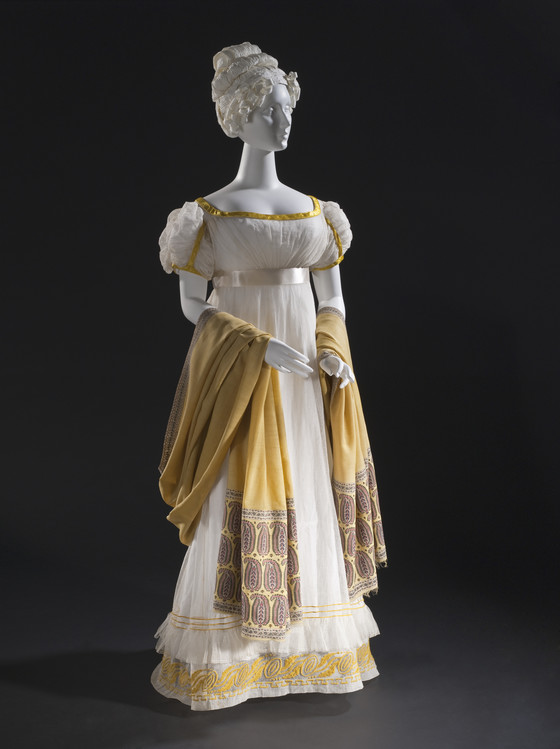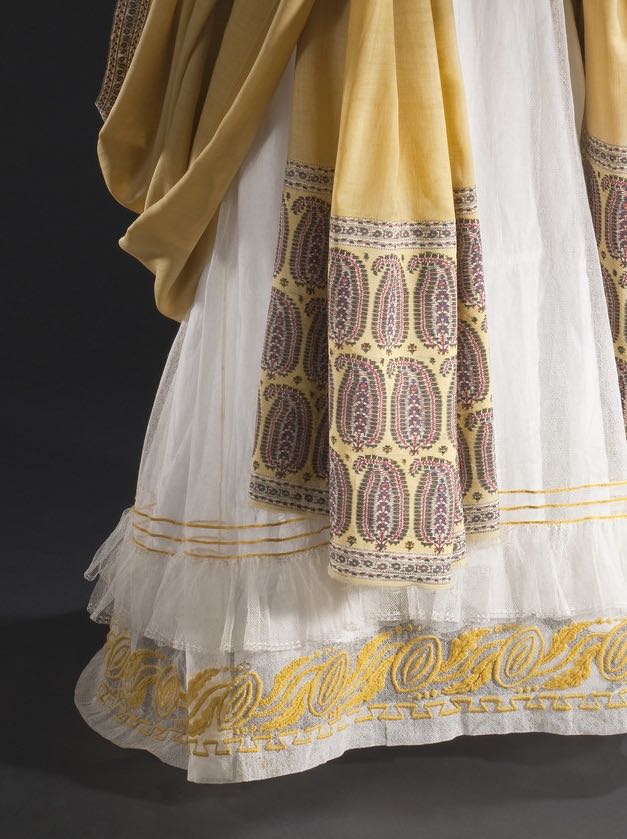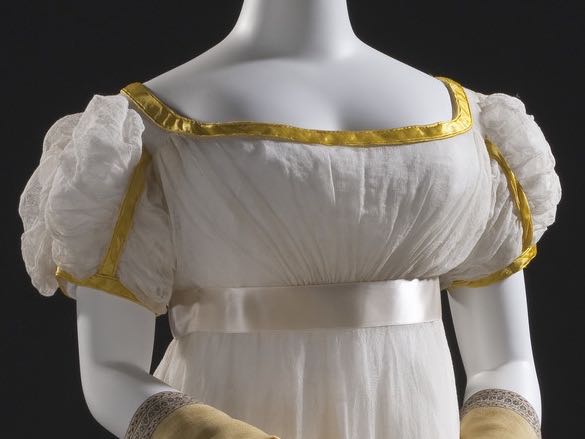Last week’s vivid blue 1909ish Grecian inspiration frock did extremely well, but not quite as well as the green velvet 1710s number from the week before. Too many of you didn’t love the trim (too heavy), or the fashion-forward tulle undersleeves (too quirky) or the pale guimpe and sleeves (which were pale because most guimpes and matching sleeves reference the idea of white chemises/undergarments peeking out and framing a coloured garment). So, with a few points lost for details, the dress came in at a still extremely respectable 8.7 out of 10.
It’s a lovely sunny (if chilly) day in Wellington today, and those of you in the Northern Hemisphere are in the middle of summer, so I thought a light, airy, sunshiny rate-the-dress was just the thing. And yellow is such a nice balance to blue, so perhaps this will do just as well as last week’s dress!

Woman’s Dress, France, circa 1820, Cotton gauze and cotton bobbin net with wool embroidery and silk satin trim, LACMA, M.2007.211.18

Woman’s Dress, France, circa 1820, Cotton gauze and cotton bobbin net with wool embroidery and silk satin trim, LACMA, M.2007.211.18
This frothy, airy concoction of a dress makes full use of John Heathcoates Old Loughborough machine for making cotton bobbin net, which he patented in 1809. The machine, based on the way traditional lace makers made lace by hand, allowed net to be produced significantly faster, making it significantly cheaper.
The machine made net could then be paired with early machine laces (which is probably what is happening at the edge of the upper ruffle), or embroidered or otherwise decorated by hand, as seen in the yellow wood embroidery around the hem of the dress:

Woman’s Dress, France, circa 1820, Cotton gauze and cotton bobbin net with wool embroidery and silk satin trim, LACMA, M.2007.211.18

Woman’s Dress, France, circa 1820, Cotton gauze and cotton bobbin net with wool embroidery and silk satin trim, LACMA, M.2007.211.18
The wool embroidery ties back to the yellow of the bodice, anchors the dress to the floor, and helps to bring in a bit of fashionable neoclassical allusions, in the form of Greek key motifs.

Woman’s Dress, France, circa 1820, Cotton gauze and cotton bobbin net with wool embroidery and silk satin trim, LACMA, M.2007.211.18
Not uncommonly for 1810s-20s fashion, the dress mixes a number of historical allusions: neoclassical and neo-gothic imagery in the wool embroidery, and Renaissance inspired puffs on the sleeves.
LACMA has added to the aesthetic mix even further by pairing the dress with a yellow kashmiri shawl with paisley/boteh motifs. The shawl, while a beautiful example of its kind, would have been at the very tail end of fashionability as an accessory for evening dress in 1820. The increasing production of kashmiri-inspired shawls in Europe (including at Paisley in Scotland, giving the motif the name it is now most commonly known by in the West), and the adaption of the Jacquard loom for the production of kashmiri-inspired shawls in 1818, had lowered the cachet of the shawls. By 1820, they are almost exclusively shown with daywear in fashion plates.

Woman’s Dress, France, circa 1820, Cotton gauze and cotton bobbin net with wool embroidery and silk satin trim, LACMA, M.2007.211.18
So, what do you think of this sheer, summery, with a concession to chilly evenings, Rate the Dress? The satin sash is almost certainly a later addition by the museum to replace a lost original, so please do not deduct points for that – though you’re welcome to speculate on what might have been there originally to make the dress perfect.
Rate the Dress on a Scale of 1 to 10

I like it. Now it may have something to do with the 100* temps here in FL but the dress looks soft, light, airy & cool even though the yellow wool embroidery on the bottom that feels a little warm. 8.5
Divine! A perfect blend of material and trim, and the yellow paisley shawl shown with it compliments the dress perfectly. I forgive the white satin sash supplied by the museum; probably the original sash was the same yellow as the ribbon trimming the sleeves and neckline.
10 out of 10.
I like it, although the proportions initially seemed a bit off to me. But on reflection I think that’s due to the shawl which wouldn’t be as big a deal on a moving person but in a still is throwing off the balance of the sleeves and bottom ruffle. That plus the weird long neck of the dummy. I think that’s what is happening? Or is it a dress for a shorter person that’s on a regular-sized dummy made shorter?
Anyhow, the dress on its own merits I give a 10/10 because I love the balance of light and airy gauze with the textured wool and the rich but bright yellow. A very happy dress and I wish it was the weather here to wear something like it!
You’re right about the long neck! I’ve never paid much attention to it, but it does throw me off in their photos.
I’m not usually fond of Regency fashions but this one is great. I really like the yellow embroidery and the way the yellow is echoed in the sleeves and neckline. I also really like how airy and light it is. I think the waist would have had a yellow sash which I think would have looked far better than the white. I’m not sure about the shawl, I’m sort of imagining it without but with a yellow and white reticule hanging from her wrist instead.
10/10
Utterly charming. Just frothy and lovely and light, and it comes together with surprising harmony, despite the disparate historical motifs. The yellow is a stunner. 10/10
It’s such a perfect spare hand with those yellow touches! I love it! And I really love the crewel? Embroidery at the hem. The bobbinet must have felt delightfully light and frothy to wear.
10/10
I like it, but I don’t love it. I think my favourite bit might be the yellow pashmina pairing, even if it is a little out of date for the dress. It’s just a little too airy for my taste – not grounded enough (I do like the wool embroidery). 8.5
I like it as a nice example of the time. I think the bright yellow is too strong though, I can’t help but think that there are few women with a light complexion that would look good in it. Women with darker skin tones would look gorgeous though. I also think that the wool embroidery feels heavy against the net gown, but on the other hand it really helps with the shaping of the skirt.
All in all a solid 7
I love it, and especially the embroidery at the hem. 10/10
So… I hate the satiny trim at the top, and kind of love the rest? It’s a weird feeling. 9/10
A gauzy, airy dress with fluffy wool embroidery and yellow silk ribbon – what’s not to love!
If I was going to pick a belt to wear with this dress I would have more wool embroidery on the belt, or a cream satin belt edged in a very thin line of the yellow ribbon (or even yellow piping), top & bottom. But an actual 1820s woman probably would have worn something plain and matte.
I’m not sure about the proportions of the bottom of the skirt – the top ruffle seems too high and too long for me, looking at it through modern eyes. 8/10
Love the dress and agree with earlier commenters that a bright yellow sash would have been lovely with it. So 9.5/10
Also I have a question about the display: the dress as displayed seems to fit a *very* full-bosomed lady. Perfectly well possible, but wouldn’t the real woman wearing it be a bit fuller in general? I find the arms and neck of the dummy disproportionately slim. More so if you consider how wide the armholes are. Are dummies this slim, or did they try to put an ‘attractive’ dummy in the dress just for viewing pleasure?
LACMA does seem to like displaying its 1810s-20s dresses on very full bosomed mannequins! I think there are a couple of things going on here. First, for many mannequin makes, even as a body size for a mannequin goes up, the arms sizes don’t – it saves the maker/purchaser money, and means different arm poses can be interchangeable across mannequins (they come off, so you can put the dress on, and then slip the arm up the sleeve and hook it in). There are a set number of mannequin shapes & sizes, and they are REALLY expensive, so museums tend to have more of the smaller ones, because they can pad mannequins to make a garment fit and have the correct historical silhouette, but they can’t put a too-small garment on a too-big mannequin. So this may be a very little mannequin padded out. In terms of conservation, you want a garment to fit correctly in the shoulders & bust, to help support the weight of the dress, but smaller arms are better, because they don’t stress the seams of the sleeves, and are less likely to cause damage as they are being put on and off.
Finally, the Western body shape has changed over the last 200 years, and one of the really big obvious ways we have changed is thicker upper arms and thighs due to better pregnancy and early childhood nutrition. I have quite a few late 19th/early 20th c clothing patterns that are far too big for me in every other respect, but that have tiny, slim sleeves I can’t fit into. I’ve also tried on 1920s dresses that were huge on me (huge for the 20s, not by a modern standard) but that had slim, narrow sleeves I couldn’t get my arms in to. So a narrower arm, proportionally is probably fairly accurate, though I’m not as familiar with specifically 1820s anatomical proportions.
So this a combination of how mannequins are made, what museums have in stock, how they are padded and dressed for conservation, and actual historical accuracy, maybe?
wow, thanks for your answer! I can image that museums do not have mannequins in every shape and size and padding is necessary, but I never would have thought that body shapes changed that much over time. The more you learn, the more interesting it gets…
Beautiful and interesting, I like how the straight lines of the yellow ribbon contrast with the embroidery and the fluffy airiness of the dress itself. 10/10
I do really love the contrast of clear, bright lemon yellow with white – (indeed, I do love the effect of most bright/contrasting colours against a white background, but yellow-and-white is reasonably less common). I think the restraint of the yellow satin is exquisite and beautifully done, and the embroidery is just right in quantity and proportion, and gives just enough unusualness to make the dress interesting. The pelmet ruffle above the embroidery is a bit quirky, but when I looked at it again, I think it kind of focuses on the embroidery, like lifting the cover off a dish to reveal something delicious beneath. I suspect the sash/belt was the same shade of yellow originally, but the cream satin is a perfectly neutral display foil that suggests what is missing while completing the look satisfactorily.
9.5/10. It’s beautiful but not ABSOLUTELY perfect.
Lemon yellow on white–I really like it. With my daughter’s coloring, it would be absolutely beautiful. 10/10
So, watching the live Beauty and the Beast, the yellow dress was a total let-down for me. Totally and completely incongruous with the rest of the film’s costuming. While 50 years too late, I wish that they would have used a more period-y dress, and this post made me irritated all over again thinking about what could have been.
I really love this and must give it a 10. It’s so light looking and very sunny! I particularly love the wrap. Just lovely.
I sighed with envy upon seeing this. The pashmina is an inspired choice in terms of coordinating without the dreaded “matchy-matchiness” (looking at it strictly from an aesthetic point, not caring about strict historical accuracy), and I love the contrast and “grounding” effect of the wool embroidery.
I see this dress worn for a walk in the park, but bringing the sunshine back inside.
10 of 10.
A lovely Regency dress, not sure that the shawl goes with it though, but it would have beenn ideal on chilly nights & these light airy dresses were worn all year. So some sort of covering would have been essential. No central heating then, houses were chilly.
Also Norwich England was a big shawl producer then well into the 1830s when they became passe.
I love the hem with all its detail, but I think the yellow satin trim at the top lacks exactly that detail.
The shawl ties it all together very nicely. I don’t I would like it this much without it.
7/10
I think it may need a petticoat. It’s not just the arms that look too narrow in comparison to the bust. The weight of the shawl is squashing the skirt…
I actually like it a lot – it’s a full 1820s hem without the usual 1820s puffiness, and yes, it’s light and airy.
9/10, because it’s not entirely an instant Ooh.
I have to give this 10/10. It’s absolutely gorgeous. It has a lovely frothiness, while still being grown-up enough for a grown woman to wear.
Gorgeous. 10/10
This is a lovely gown in dreamy colors. I am not a fan, though, of Regency Renaissance-inspired sleeves. There is too much “lemon meringue puff” going on at the top for my taste.
Now…if I cover up the sleeves, the dress becomes a 9.5. As is, I have to rate it a 7.
I love all of it except the sleeves, they’re just too frothy for the rest of the dress and pull it down. I’m suspecting the original sash would have been the same colour as the neck trim, based on that I’m going to give it 7/10, it lost 3 points for those sleeves
I’m in love! 10/10 (assuming a matching yellow sash.)
It does look delightfully cool, and with the way they bound them even the puffed sleeves look wearable. I do think a more matte sash would have been preferred, but I’m glad they chose white instead of yellow – let’s not have too much of a good thing. Paring with the shawl was also genius, even if not strictly likely in a historical sense (and thank you for the notes about arms and mannequins! Fascinating). But the thing that stands out to me is the difference in color between photos. Obviously lighting is wreaking havoc on the yellows – close up they’re lemon but stand back and they go golden-mustard. I much prefer the latter, darker coloring with the white and so am blithely rating it with the assumption that that is the actual shade.
8/10
I love this dress. 10/10 for me.
I love this dress so much (even with the shawl) to put it on my list to recreate.
I think yellow is a wonderful colour and this dress doesn’t over do it.
9.5/10 – the fact that the yellows on the collar and hem don’t quite match irritates me just a bit. I also really don’t think the sash is doing anything for it (especially given, again, the fact that it blatantly doesn’t match the yellow on the gown), but other than that I am in love.
it’s a kowhai dress!
I’m glad you said not to include the sash in our rating because I don’t like it – way too shiny. Otherwise, a nicely balanced frock. A solid 8/10.
I have to take a lot of things into consideration with this frock. I like the shape and how light and airy it is but I don’t like the yellow. I like the yellow embroidery at the bottom but not the trim at the top. In one picture the yellow at the top looks banana color and in another it doesn’t look that bright. I like the one that is not bright but the banana-ish color I don’t like at all (mostly because I’m one who can not wear yellow).
You are very right about summer here, its hot hot hot! I would probably wear this today, regardless of the color just because of how hot it is here.
So taking into account that the wearer probably looked really pretty in this I’m going to give it a 9 out of 10. A few things have me on the fence about a 10 so I’ll stick with 9.